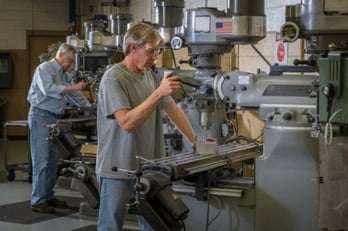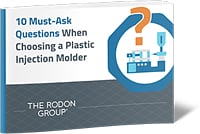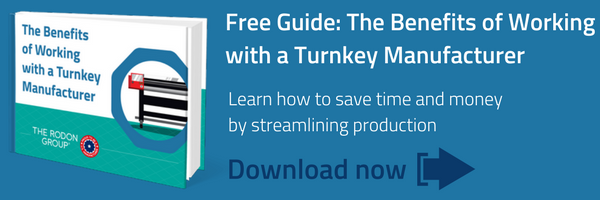One of the most common questions for those looking to source a plastic injection molder is “How much will a plastic injection mold cost?” It’s one of the most important questions since the actual mold represents the most significant expense in upfront production costs. That being said, many factors go into determining the full cost. With any custom injection molding project, your injection molder should be able to give you the final price tag. In this article, we will review the variables that can impact the cost so that you can be better informed when making a mold purchasing decision.
Maximizing ROI in Injection Molding — Understanding Cost Factors
To calculate the total cost, injection molding projects have four key variables: the equipment, mold, materials, and related services. By learning the details of each cost factor, you can understand the total cost and select the right materials and service provider for your future projects.
Equipment Costs
Injection molding processes require specialized equipment that can handle precision work at high temperatures and pressure levels. Some machines are small and can produce a few parts per production run. These desktop units are commonly used by companies that want in-house production capabilities. Industrial-sized units, commonly owned by companies specializing in large-scale injection molding, can produce hundreds or thousands of units much more quickly.
The cost of an industrial machine ranges from $50,000 to over $200,000. Along with that direct cost, organizations will also be responsible for more stringent facility requirements and need to pay for skilled technicians who know how to efficiently operate, monitor, and maintain the equipment. Because of the equipment and auxiliary costs, most organizations opt for outsourced injection molding services. Third-party contract manufacturers roll a small portion of these costs into the service charges, which is often preferable for any organization that doesn’t specialize in injection molding services themselves.
Mold Costs
This is often the most expensive portion of total injection molding costs. Tooling costs and creating the actual mold are expensive, so it’s important to consider all the potential cost factors within this category. In addition to the complexity of the mold and the materials used, one of the biggest factors is the mold creation process, which can involve one of three main methods:
- CNC Machining: Fully or partially automated, CNC machines can precisely create stainless steel or aluminum molds within strict tolerances. This equipment creates molds by using a spinning tool to remove excess material from a stationary workpiece. They can produce molds with highly complex cavities, but increased complexity will increase the time needed, thereby increasing the cost of production.
- Electrical Discharge Machining (EDM): When you need an extremely complex mold that standard CNC machining setups can’t create, EDM is ideal. Operators use an automated electrode tool to remove excess material from a workpiece. Because this process is so accurate, the mold will not need to undergo post-process finishing.
- 3D Printing: With 3D printing, operators can print a mold using thin layers of a substrate to create a highly precise 3D design. It can be automated and doesn’t require a lot of expensive equipment. This makes it an excellent option for prototype molds; once your organization has finalized the design, the final mold can be hard-tooled.
Injected Material Costs
Injection molding processes inject a liquid plastic material into the mold, where it cures or cools into a solid final form. Different plastics (as well as additives that provide colors and enhanced characteristics) each have a different cost. Thermoplastic pellets may cost between $1 and $5 per kilogram depending on the specific type of material. Popular options are acrylonitrile butadiene styrene (ABS), polyethylene (PE), polypropylene (PP), polystyrene (PS), thermoplastic polyurethane (TPU), and polycarbonate (PC). The total material cost will vary based on the amount of material required and the mold’s design.
Service Costs
While injection molding tools are becoming increasingly automated, some labor costs are still involved. These include manual setup and configuration costs to get the equipment ready, repair costs for keeping the machines in good operating condition, and monitoring costs for operators to check the progress of the production process.
Variables That Impact the Cost of a Plastic Injection Mold
There are also strategic variables that can affect the project’s total cost, such as what material the mold should be made from and the size of each injection molded unit. Here’s an overview of each of these variables.
Time Is Money (Production Volume)
Consider the production volume before constructing the mold. Prototypes and small-volume runs can use 3D-printed molds, which are generally softer and wear through faster. But high-volume runs benefit from harder, more expensive molds that can withstand many production cycles. Also, while harder molds may have a higher price tag, the cost can be split across a much larger number of produced parts.
Part Size
Larger parts will require more injection molding material than smaller ones, but that’s not the only cost consideration. Larger products also require larger molds, which can drastically affect the final cost: larger molds are more expensive than smaller molds.
The Core Metal
For shorter production runs, some mold makers will use molds made from aluminum. This is a perfectly reasonable choice if you will not need the mold to perform long-term. However, if a project requires that a mold last for several years, an aluminum mold may cost more in the long run.
The Number of Cavities
It is pretty intuitive when you think about it. Fewer cavities in a mold require less tooling work and time and ultimately less cost. A reputable, experienced molder will be able to maximize cavitations in the mold to maintain the highest level of productivity. In general, most molders recommend creating one mold per part versus creating a family mold. Family molds are created with various cavities for assorted parts. They tend to produce inferior products and have more downtime due to maintenance issues.
Mold Base
Think of the mold base as a case that holds all of the mold cavities, inserts, and components together. The cost of the base is estimated based on the size of the mold and the type of steel used to make the base as well as the customization required. Most mold bases come in standard sizes and are further machined to meet the requirements of a specific project.
Core/Cavity Machining
All molds must also be customized. Customization includes the placement of cores, cavities, ejectors, and cooling lines. The steel used in the tool also impacts cost. Hardened steel molds last the longest and are more expensive to machine. Once done, however, they have a long production life.
Part Complexity
Just as the number of cavities plays a role in determining the cost of the mold, so does part complexity. This includes the surface finish of the final part as well as the number of undercuts required. Parts, which demand tight tolerances, also contribute to mold complexity.
Comparing Quotes
Procurement and purchasing managers have the unenviable task of obtaining quotes from a few injection molders for each project. Depending on the input (in terms of drawings, prototypes, or sample parts), the cost quotes can vary greatly. Designers should also look at all of these inputs and determine the best molding solution.
They may redesign the part to maximize manufacturing efficiency and increase the number of components that can be made with each molding cycle. Generally, molds made with tighter tolerances, more cavities, and a longer production life will take longer to build and will cost more upfront. The savings with a high-quality mold are long-term. These molds require less maintenance and last longer than lower-quality molds.
The Merits of Building a Mold in the U.S.
 The Rodon Group has been in this business long enough to have worked with, or attempted to work with, molds that were created in Asia (most often, China). Many of these molds are not built to meet strict tolerances, since they don’t have to be. As labor costs rise in China, this no longer becomes an affordable manufacturing process.
The Rodon Group has been in this business long enough to have worked with, or attempted to work with, molds that were created in Asia (most often, China). Many of these molds are not built to meet strict tolerances, since they don’t have to be. As labor costs rise in China, this no longer becomes an affordable manufacturing process.
In addition, molds made in other countries are made from lesser-quality steel or aluminum. Again, this causes quality issues and shortens the life of the mold. Most high-production molders in this country use only the best stainless steel available for the mold base and cavities. They utilize the latest technology in CNC machining and have seasoned tool makers who know how to create molds that meet the highest performance standards. When sourcing companies, be sure to look for U.S.-based manufacturers.

10 Must-Ask Questions eBook
What you need to know before selecting a molder for your project
Download our eBook, “10 Must-Ask Questions When Choosing a Plastic Injection Molder.” Inside, we cover key questions like:
- Does the molder guarantee the molds for the life of a project?
- How many molding machines do they have and what are their capabilities?
- Is their pricing competitive, even when comparing with offshore molders?
Turnkey Injection Molders
Some mold builders also manufacture the parts. This type of integration can help defray the mold building cost. Often full service, turnkey molding manufacturers will subsidize a portion or all of the cost of the mold based on the full term and value of the manufacturing contract. They will amortize the cost of the mold so they can maintain profit margins while providing the lowest possible per-piece cost to their clients.
Learn More About Injection Molding With The Rodon Group
The cost of a quality injection mold is undoubtedly a significant expense. However, tight-tolerance, precision molds that are made from the best steel available should last for years to come. The upfront cost must be calculated or amortized into the lifetime value of the project. Will these parts be in production for several years or several months? Does the project require a high volume of parts? Are faster cycle times needed? If you answered yes to these questions, then the initial investment in a quality mold will lower the per-part cost and will end up saving money in the long run.
We hope this overview of key cost factors helps you in getting and comparing quotes for your future projects. Working with a reputable on-shore molder, with a long history of mold building for various industries, is a great place to start your bidding process. Contact us if you have questions about injection molding, or request a quote for our services.










Comments